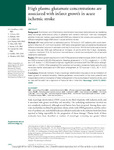High plasma glutamate concentrations are associated with infarct growth in acute ischemic stroke

Non accesible ata 9999-99-99
Use este enlace para citar
http://hdl.handle.net/2183/40802Coleccións
- Investigación (FCS) [1293]
Metadatos
Mostrar o rexistro completo do ítemTítulo
High plasma glutamate concentrations are associated with infarct growth in acute ischemic strokeAutor(es)
Data
2008-12-02Cita bibliográfica
Castellanos M, Sobrino T, Pedraza S, Moldes O, Pumar JM, Silva Y, Serena J, García-Gil M, Castillo J, Dávalos A. High plasma glutamate concentrations are associated with infarct growth in acute ischemic stroke. Neurology. 2008 Dec 2;71(23):1862-8.
Resumo
[Abstract] Background: Excitotoxic and inflammatory mechanisms have been demonstrated as mediating early neurologic deterioration (END) in patients with cerebral infarction. Here we investigate whether molecular markers associated with END are related to the volume and outcome of the diffusion weighted image (DWI) lesion in acute ischemic stroke.
Methods: MRI was performed on admission and at 72 hours in 197 patients with acute hemispheric infarction of <12 hours' duration. DWI lesion enlargement was calculated as the absolute difference between volumes on admission and day 3 of evolution. NIH Stroke Scale was scored at the same intervals. END was defined as an increase >/=4 points within the 3 days. Glutamate, l-arginine, interleukin-6 (IL-6), and tumor necrosis factor-alpha levels were analyzed in blood samples obtained on admission.
Results: DWI lesion growth was found in 144 (73%) patients (median increase 38 [6.5, 83.4] cm(3)) and END occurred in 58 (29.4%) patients. Baseline glutamate (r = 0.71), l-arginine (r = -0.35), and IL-6 levels (r = 0.50) showed a high and significant correlation with the DWI lesion enlargement (all p < 0.001). After adjustment for potential confounders, glutamate levels were the only molecular marker associated with DWI lesion enlargement at 72 hours (beta = 0.21; SD = 0.07; p = 0.004).
Conclusions: Molecular markers of early neurologic deterioration may play a role as mediators of lesion growth in cerebral ischemia. Plasma glutamate concentration is the most powerful and independent predictor biomarker of lesion enlargement in the acute phase of ischemic stroke, and so may well be useful as a signature of tissue at risk of infarction.
Palabras chave
Cerebral infaction
Glutamic acid
Stroke
Glutamic acid
Stroke
Versión do editor
ISSN
0028-3878





